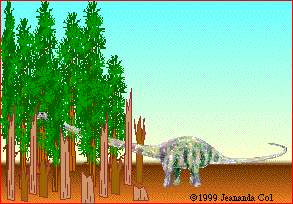
 |
| Our subscribers' grade-level estimate for this page: 2nd - 3rd |
| ZoomDinosaurs.com ALL ABOUT DINOSAURS! |
| What is a Dinosaur? | Dino Info Pages | Dinosaur Coloring Print-outs | Name That Dino | Biggest, Smallest, Oldest,... | Evolution of Dinosaurs | Dinos and Birds | Dino Myths |
| Millions of years ago, long before there were any people, there were dinosaurs. Dinosaurs were one of several kinds of prehistoric reptiles that lived during the Mesozoic Era, the "Age of Reptiles." |  Dinosaurs were reptiles and most hatched from eggs. No dinosaurs could fly and none lived in the water. |
Plant-eating sauropods were the largest animals to ever walk on Earth - but blue whales are more massive than any of the dinosaurs were! |
The largest dinosaurs were over 100 feet (30 m) long and up to 50 feet (15 m) tall (like Argentinosaurus, Seismosaurus, Ultrasauros, Brachiosaurus, and Supersaurus). The smallest dinosaurs, like Compsognathus, were about the size of a chicken. Most dinosaurs were in-between. |
| It is very difficult to figure out how the dinosaurs sounded, how they behaved, how they mated, what color they were, or even how to tell whether a fossil was male or female. | No one knows what color or patterns the dinosaurs were. |
 Most dinosaurs were plant-eaters (also called herbivores). For example, Triceratops was a plant-eating dinosaur.  Some dinosaurs were meat-eaters (also called carnivores). For example, T. rex was a meat-eating dinosaur. |
There were lots of different kinds of dinosaurs that lived at different times.
|
| The dinosaurs dominated the Earth for over 165 million years during the Mesozoic Era, but mysteriously went extinct 65 million years ago. Paleontologists study their fossil remains to learn about the amazing prehistoric world of dinosaurs. |
 The dinosaurs went extinct 65 million years ago, probably because of the environmental changes brought about by an asteroid hitting the Earth. |
Some dinosaurs were very bird-like and may be the ancestors of today's birds. |
 There are almost 500 described dinosaur genera and many more species. Every few months (sometimes weeks), new finds are unearthed. |
|

 (and Other Prehistoric Creatures) |
| ZoomDinosaurs.com ALL ABOUT DINOSAURS! |
| What is a Dinosaur? | Dino Info Pages | Dinosaur Coloring Print-outs | Name That Dino | Biggest, Smallest, Oldest,... | Evolution of Dinosaurs | Dinos and Birds | Dino Myths |
Enchanted Learning®
Over 35,000 Web Pages
Sample Pages for Prospective Subscribers, or click below
|
Overview of Site What's New Enchanted Learning Home Monthly Activity Calendar Books to Print Site Index K-3 Crafts K-3 Themes Little Explorers Picture dictionary PreK/K Activities Rebus Rhymes Stories Writing Cloze Activities Essay Topics Newspaper Writing Activities Parts of Speech Fiction The Test of Time
|
Biology Animal Printouts Biology Label Printouts Biomes Birds Butterflies Dinosaurs Food Chain Human Anatomy Mammals Plants Rainforests Sharks Whales Physical Sciences: K-12 Astronomy The Earth Geology Hurricanes Landforms Oceans Tsunami Volcano |
Languages Dutch French German Italian Japanese (Romaji) Portuguese Spanish Swedish Geography/History Explorers Flags Geography Inventors US History Other Topics Art and Artists Calendars College Finder Crafts Graphic Organizers Label Me! Printouts Math Music Word Wheels |
Click to read our Privacy Policy
| Search the Enchanted Learning website for: |